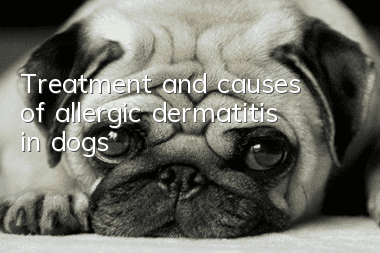Treatment and causes of allergic dermatitis in dogs

Dog allergies are a problem that many parents are worried about now, because we can’t know what a dog is allergic to before he is allergic, and the symptoms of dog allergies are different. Therefore, many parents cannot judge at the first time. When it comes to whether dogs are allergic, what are the causes of dog allergies? And how to treat them?
Australian Cattle Dog
1. Causes of allergic dermatitis in dogs:
1. Endogenous: hereditary, hormonal abnormalities and allergic predispositions.
2. Exogenous There are seasonal and non-seasonal environmental factors. Inhalation of pollen, dust, wool, etc., and ingestion of horse meat, ham, milk and other foods. In addition, injection drugs, mosquito bites, internal and external parasites and pathogen infections, as well as physical and chemical factors, etc.
Endogenous factors usually refer to causes such as genetics, hormonal abnormalities, and allergic constitution. Exogenous factors range widely, and some have obvious seasonality. Such as inhaling pollen, dust, mites, dander, etc., ingesting spoiled meat and milk, injecting drugs, serum, mosquito bites, contact with chemicals, excessive sun exposure, etc.
It is more common in dogs aged 1 to 3 years old. The initial sites are around the eyes, between toes, armpits, groin, perineum and lower back. The main symptoms of sick dogs are severe itching, erythema and swelling, and some have papules, scales and hair loss. In the long course of the disease, pigmentation, skin thickening, lichen formation, and wrinkles may occur. Chronic itching is milder or disappears, but some cases last for more than a year.
2. Symptoms of allergic dermatitis in dogs:
The main symptoms of allergic dermatitis in dogs and cats are red rash and itching. Drug allergies often occur clinically. For example, subcutaneous injection of vidinine calcium, vitamin K1, K3, intravenous injection of Houttuynia cordata and other drugs will cause animals to develop skin rash, salivation, eye, lip or abdominal swelling and itching. and symptoms such as scratching by animals.
Food allergy is relatively common in dogs. Food allergy is also an allergic reaction. It is necessary to change the food ingredients to overcome the symptoms of skin hair loss and itching.
Bacterial allergies must be diagnosed through laboratory diagnosis. Itching causes animals to scratch their skin, causing secondary bacterial skin diseases. The diagnosis of allergic skin diseases requires immunological diagnostic tests for allergens.
3. Treatment of allergic dermatitis in dogs
If you want to treat allergic dermatitis in dogs, you must first find out the cause of the dog's allergy, and then treat it accordingly. But sometimes dogs are allergic to dust, sunlight or mites, and it is difficult for us to completely remove these allergens. At this time, we can use antihistamines to relieve itching.Steroids to control inflammation, drugs to suppress allergies, or anti-itching and anti-inflammatory drugs. Next, let’s talk about the treatment of allergic dermatitis in dogs.
1. Food-induced allergic dermatitis
Dogs are omnivores, but many parents dote on their dogs too much and always feed them various canned foods, snacks, or human delicacies. This appears to be about loving dogs, but in fact it will cause various problems in dogs, such as obesity, dry hair, excessive dandruff, allergic dermatitis, etc. But the good news is that no matter what season it is, food allergies are relatively easy to control. If you suspect that your dog has food-induced dermatitis, it is recommended that you ask your dog to eat hypoallergenic food/allergy-controlled food from the prescription dog food on the market for about a month, and it will usually be basically improved.
2. Allergic dermatitis caused by sun exposure
Since dogs’ skin is thinner than that of humans, they are more susceptible to allergic dermatitis due to sunlight exposure. Normally, a dog's hair will help the dog resist part of the sun's rays. But some parents are afraid that their dogs will be hot, so they shave their dogs completely as soon as summer comes. This is very harmful to dogs. Because the sun is strong in summer and the ultraviolet rays are strong, the dog's hair can help absorb and reflect the pipes and resist ultraviolet rays. But if you shave your dog's hair, even if it is exposed to the sun for just 20 minutes, the dog will still be damaged by the sun early, and in severe cases, the skin will become red and itchy. At this time, the dog feels uncomfortable on the skin and will naturally scratch it with its paws or lick these parts with its tongue. This will cause more serious physical damage and easily cause bacterial infection. So please remember that when cutting your dog’s hair in summer, be sure not to shave it completely.
3. Allergic dermatitis caused by superficial parasites
Parasites can easily cause allergic dermatitis in dogs. Common parasites include: lice, dog ticks, fleas, mites, etc. Ticks can easily cause unbearable itching in dogs, and can also cause hair loss, eczema, blisters, pustules, etc. Dog ticks have strong blood-sucking abilities and usually stick to the dog's head, ears, and toes. After sucking blood, the dog tick will become sick. It can swell dozens of times and easily cause inflammation of the dog's skin; fleas often live on the waist, abdomen and inside of the limbs of dogs, survive by sucking the dog's blood, and secrete toxins, which can easily cause itching, hair loss and diseases of the dog's skin. Atopic dermatitis. The treatment method is to first remove the parasites from the dog, and then use antihistamines to relieve itching, steroids to suppress inflammation, drugs to suppress allergies, or anti-itching and anti-inflammatory drugs. The most important way to deal with parasites is to improve dog hygiene, deworm dogs regularly, and avoid letting dogs go to places with dense plants.
4. Allergic dermatitis caused by improper body surface contact
Compared with other allergies, allergic dermatitis caused by improper contact is more specific. For example, some dogs are allergic to perfumes, some dogs are allergic to the fabrics of some pet clothes, some dogs are allergic to topical drugs, etc. Symptoms of these allergies usually appear within 2 hours of contact with the object. The dog will scratch these areas, and some dogs will have red and swollen eye circles. Normally, as long as you stay away from the contact object, these allergic symptoms will disappear on their own after a while, but if the dog is still like this after 3 hours, or it becomes more serious, it is recommended that you take your dog to the hospital immediately and let the doctor help him recover as soon as possible.
- How to treat urinary tract stones in dogs? Dogs may need surgery!
- What should I do if my dog has no milk? The owner should check quickly and don’t let the puppies starve to death.
- Dog’s anal gland odor, please note that this is a sign of your dog’s health!
- What are the symptoms of dog pain? How to detect dog pain early
- How to make your dog like to eat dog food Four ways to make your dog fall in love with dog food
- Can dogs digest peach pits if they eat them? Can dogs digest peach pits if they accidentally eat them?
- How to protect your dog’s food? Teach you tips on training your dog
- Why do dogs defecate everywhere? How can dogs stop defecating everywhere?
- What should I do if my dog has lupus? Immune system diseases should not be underestimated
- If your dog's hair is cut and the skin is cut, the flesh is exposed. If the dog's hair is accidentally cut and the skin is cut, it must be disinfected immediately.



